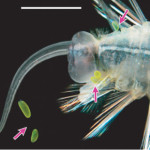![]() Beginning with Victorian science and progressing through the onset of modern deep-sea biology, the dominant paradigm was that the deep sea was a stable ecosystem. Organisms, and the communities that contained them, were unchanging because the deep ocean was buffered against climatic variability. Move head to the 1980’s and beyond and the picture has changed considerably. Work led by John Gage, Paul Tyler, Craig Young demonstrates that many species exhibit seasonal reproduction. Work by Ken Smith and Henry Ruhl here at MBARI reveals an ecosystem where biodiversity shifts are triggered by El Nino events. The paradigm now is one of a dynamic system intimately related to seasonal, annual, and decadal changes in surface production and ocean currents. A system that is not buffered against climate alterations at our hands.
Beginning with Victorian science and progressing through the onset of modern deep-sea biology, the dominant paradigm was that the deep sea was a stable ecosystem. Organisms, and the communities that contained them, were unchanging because the deep ocean was buffered against climatic variability. Move head to the 1980’s and beyond and the picture has changed considerably. Work led by John Gage, Paul Tyler, Craig Young demonstrates that many species exhibit seasonal reproduction. Work by Ken Smith and Henry Ruhl here at MBARI reveals an ecosystem where biodiversity shifts are triggered by El Nino events. The paradigm now is one of a dynamic system intimately related to seasonal, annual, and decadal changes in surface production and ocean currents. A system that is not buffered against climate alterations at our hands.
Yet this picture of the deep sea is based on a relatively small snapshot of geologic time and thus lacks a vital component. We know little of how deep-sea systems respond on geologic timescales. Work this week in Proceedings of the National Academy of Science by Yasuhara et al. details a violent history of ecological collapses on the deep-sea floor.
Utilizing fossilized ostracods (small bivalved Crustaceans) from cores taken in the Atlantic, they are able to recreate the last 20,000 years. During major oceanographic changes up to 50% of ostracod species were replaced. Imagine half the species in your favorite dive or hiking spot being replaced with totally new species. These biodiversity shifts occurred during centennial-millennial scale cooling events that altered oceanographic currents and surface production of plankton. This sinking plankton is the major food source for most deep-sea organisms. The largest disruptions occurred during the Heinrich Event 1(1), the Inter-Allerod Cold Period (2), the Younger Dryas (3), and several Holocene Bond events (4). The absolute largest occurred during the Younger Dryas/Inter-Allerod Cold Period that required over 8,000 years for the ostracods to fully recover.
(1) episode during the last glacial period where several glaciers cleaved a vast number of icebergs that traversed the North Atlantic, distinguished by 6 separate events (1-6) H1 occurred between 16,800-14,000 years ago
(2) the Allerod Period occurs at the end of the last glaciation when temperatures in the North Atlantic rose close to present day level, a cooling period ensues afterward lasting about 200 years
(3) A period after the Inter-Allerod Cold Period known as the Big Freeze occurring between 12,700-11,500 years before present
(4) Quasi-1500 year climate cycles occurring in the North Atlantic
Yasuhara, M., Cronin, T.M., deMenocal, P.B., Okahashi, H., Linsley, B.K. (2008). From the Cover: Abrupt climate change and collapse of deep-sea ecosystems. Proceedings of the National Academy of Sciences, 105(5), 1556-1560. DOI: 10.1073/pnas.0705486105






So did recovery occur through migration of shallower species to depth with shift in water mass or radiation of species after stressful period? Is this mentioned in the paper?
This looks very important for our understanding of climate change. Thanks for the link to the abstract. I hope others continue this line of research.
Yes, the idea that climate is stable and rarely changes is breaking down in the face of events and research. Research alone I think could not sway public opinion, but events have a way fo hitting home with folks. Extensive tornado systems, Cat 5 hurricanes, huge systems of forest fires, and devastating heat waves and freeze-overs have a way of cutting through the denialists pat assertions to not worry, it’s all natural.
The study indicates that even if the idea that it’s all natural were true, there would be no cause for smugness. The cores seem to indicate nature can upheave herself in a century or less, and in fact does so every few thousand years. The last sentence from the abstract says it quite well:
These results indicate that deep-sea ecosystems are not immune to the effects of rapid climate changes occurring over centuries or less.
While I have some sympathy for those concerned about the effects of rapid climate change, I can only deplore the alarmist-biased error in this summary. From above:
From the abstract of the linked article:
For language-challanged readers, the latter means that the recovery was completed in {approx}5Kyears, by {approx}8Kyears ago. While this still represents a catastrophic upheaval, it’s not as serious, and, in addition, there is no implication that the recovery is still in progress.
Furthermore, also from the abstract:
What this indicates is that the process of collapse and recovery is a normal part of the evolutionary process, not some sort of “injury” to nature.
I am not sure how you find the article, or this summary of it, alarmist. There was more than enough evidence in the article, which I summarized succinctly, to suggest that there indeed was a deep-sea ecosystem collapse. If you’ll look at figure 2, you will note during the largest event species diversity (as measured by Shannon’s H’) was reduced to half. Moreover, considerable community shifts occurred during this time (same figure as noted by the varimax factor loadings). To restate, a different and less diverse community took over. As the authors note “the deep-sea community in general, as indicated by low species diversity, which suggests stressed environments.” As you mention this was a time when slope species “prospered”, i.e. migrated to this deeper abyssal location. These were opportunistic species that would not have migrated to this study site if the original assemblage had not been compromised and the oceanographic conditions had not changed considerably. An error in my part did occur in the summary above, the “recovery” (authors words not mine), or a return to the original assemblage did not take 8,000 years but rather 5,000 years approximately 8,000 years ago. However, the 3,000 year mistake makes doesn’t alter the conclusions. It is still remarkable, and interesting, that diversity and community structure would radically cycle over such a small timespan. Additionally, the article points to deep-sea systems not being as buffered against climate change, whether historically or in the future, as previously thought. I don’t think that I ever argued that is was unnatural or not part of collapses/recoveries that permeate the fossil record. Perhaps you are taking me to task for the comment “violent history of ecological collapses” which I don’t find alarmist at all but rather an adequate description to characterize radical shifts in deep-sea communities. Note I also never related this to current climate change whatsoever.
I can only deplore the alarmist
I deplore the use of such bad faith propaganda terms.
some sort of “injury” to nature
The notion of injury to nature is incoherent. Injury to our interests, OTOH, is not. Those who deflect concern with talk about events being “natural” are trucking in irrelevant tautology.
I think Craig pretty much answered the criticisms very well. But I would like to add that this study was a historical one that linked climatic conditions with faunal abudances and species richeness/composition in the past. What it does a good job showing is that faunal communities in the deep ocean respond to changes at the surface. ‘Climate’ is surrogate for the sum of all the abiotic changes happening at the surface: temperature, salinity, solar radiation, albedo, etc. All those changes affect the fauna making a living at the surface. Since, as craig mentioned in the post, deep sea abyssal fauna get their nutrients from the carcasses and organic matter “raining” down from the surface, the abundance of life at the top has a direct corollary with the abundance of life on the bottom. Hence, severe changes in climate directly affects the chain from bottom up. A fast change leaves little time for adaptation to the new environment to happen and results in mass die offs of populations, or species.